Optimal On-Load Tap Changer Tap Control Method for Voltage Compliance Rate Improvement in Distribution Systems, Based on Field Measurement Data
Abstract
:1. Introduction
- (1)
- An optimal OLTC tap control method is proposed to ensure effective voltage regulation across all feeders. The controller operates according to a discrete-time system, applying the optimal OLTC tap at predefined, fixed control intervals.
- (2)
- To describe the voltage quality for all the feeders connected to M.TR, SNB-VCR is proposed as a performance index to be maximized.
- (3)
- The maximization problem of the SNB-VCR is solved by the gradient ascent method.
- (4)
- The proposed method implements a controller using the measurements of smart metering systems as feedback signal.
2. Voltage Management in Distribution Network
2.1. Conventional Methods for OLTC Tap Changing and Their Limitations
2.2. Voltage Compliance Rate
3. OLTC Optimal Tap Control for Improving VCR
3.1. Relationship Between OLTC and VCR
3.2. SNB-VCR Analysis Using Field Measurement Data
3.3. Proposed Optimal Control Method for OLTC
4. Verification
4.1. Scheme of Electric Network and Regulatory Objects
4.2. Voltage Distribution When Optimal Tap Is Selected
5. Conclusions
Author Contributions
Funding
Data Availability Statement
Conflicts of Interest
References
- Vaishya, S.R.; Abhyankar, A.R.; Kumar, P. A Novel Loss Sensitivity Based Linearized OPF and LMP Calculations for Active Balanced Distribution Networks. IEEE Syst. J. 2023, 17, 1340–1351. [Google Scholar] [CrossRef]
- Zhang, Z.; Dou, C.; Yue, D.; Zhang, Y.; Zhang, B.; Li, B. Regional Coordinated Voltage Regulation in Active Distribution Networks with PV-BESS. IEEE Trans. Circuits Syst.-II Express Briefs 2023, 70, 596–600. [Google Scholar] [CrossRef]
- Gorbachev, S.; Mani, A.; Li, L.; Li, L.; Zhang, Y. Distributed Energy Resources Based Two-Layer Delay-Independent Voltage Coordinated Control in Active Distribution Network. IEEE Trans. Ind. Inform. 2024, 20, 1220–1230. [Google Scholar] [CrossRef]
- Khan, M.A.; Saleh, A.M.; Waseem, M. Sajjad, I.A. Artificial Intelligence Enabled Demand Response: Prospects and Challenges in Smart Grid Environment. IEEE Access 2023, 11, 1477–1505. [Google Scholar] [CrossRef]
- Hasan, E.O.; Hatata, A.Y.; Badran, E.A.E.; Yossef, F.H. Voltage Control of Distribution Systems Using Electronic OLTC. In Proceedings of the 2018 Twentieth International Middle East Power Systems Conference (MEPCON), Cairo, Egypt, 18–20 December 2018. [Google Scholar]
- Li, C.; Disfani, V.R.; Haghi, H.V.; Kleissl, J. Optimal Voltage Regulation of Unbalanced Distribution Networks with Coordination of OLTC and PV Generation. In Proceedings of the 2019 IEEE Power&Energy Society General Meeting, Atlanta, GA, USA, 4–8 August 2019. [Google Scholar]
- Matei, G.G.; Neagu, B.C.; Gavrilas, M. Optimal Voltage Control Based on a Modified Line Drop Compensation Method in Distribution Systems. In Proceedings of the 2018 IEEE International Conference on EEEIC/I&CPS Europe, Palermo, Italy, 12–15 June 2018. [Google Scholar]
- Muttaqi, K.M.; Le, A.D.T.; Negnevitsky, M.; Ledwich, G. A Novel Tuning Method for Advanced Line Drop Compensator and Its Application to Response Coordination of Distributed Generation With Voltage Regulating Devices. IEEE Trans. Ind. Appl 2016, 52, 1842–1854. [Google Scholar]
- Li, P.; Sui, H.; Wang, K.; Zhang, S.; Li, G. An Optimized 3-Dimensional Simulation of On-load Tap Changer Subjected to Short Circuit Current. In Proceedings of the 2022 IEEE International Conference on High Voltage Engineering and Applications (ICHVE), Xiamen, China, 2–4 December 2021. [Google Scholar]
- Akagi, S.; Takahashi, R.; Kaneko, A.; Ito, M.; Yoshinaga, J.; Hayashi, Y. Upgrading Voltage Control Method Based on Photovoltaic Penetration Rate. IEEE Trans. Smart Grid 2016, 9, 3994–4003. [Google Scholar] [CrossRef]
- Yan, R.; Saha, T.K. Investigation of Voltage Stability for Residential Customers Due to High Photovoltaic Penetrations. IEEE Trans. Power Syst. 2012, 27, 651–662. [Google Scholar] [CrossRef]
- Wang, L.; Yan, R.; Saha, T.K. Voltage Management for Large Scale PV Integration into Weak Distribution Systems. IEEE Trans. Smart Grid 2017, 9, 4128–4139. [Google Scholar] [CrossRef]
- Kojovic, L.A. Coordination of distributed generation and step voltage regulator operations for improved distribution system voltage regulation. In Proceedings of the 2006 IEEE Power Engineering Society General Meeting, Montreal, QC, Canada, 18–22 June 2006. [Google Scholar]
- Le, A.D.T.; Muttaqi, K.M.; Negnevitsky, M.; Ledwich, G. Response coordination and tap changers for voltage support. In Proceedings of the 2007 Australasian Universities Power Engineering Conference, Perth, WA, Australia, 9–12 December 2007. [Google Scholar]
- Muttaqi, K.M.; Le, A.D.T.; Ledwich, G. A Coordinated Voltage Control Approach for Coordination of OLTC, Voltage Regulator, and DG to Regulate Voltage in a Distribution Feeder. IEEE Trans. Ind. Appl. 2015, 51, 1239–1248. [Google Scholar] [CrossRef]
- Long, C.; Ochoa, L.F. Voltage Control of PV-Rich LV Networks: OLTC-Fitted Transformer and Capacitor Banks. IEEE Trans. Power Syst. 2016, 31, 4016–4025. [Google Scholar] [CrossRef]
- Nakamura, M.; Kaneko, A.; Yoshizawa, S.; Ishii, H.; Hayashi, Y. Impact of Smart Meter Measurement Granularity on Control Parameters of OLTC in Distribution Networks with PV. In Proceedings of the 2022 IEEE Power & Energy Society Innovative Smart Grid Technologies Conference (ISGT), New Orleans, LA, USA, 24–28 April 2022. [Google Scholar]
- Gevaert, L.F.M.; Vandoorn, T.L.; Deckmyn, C.; Vyver, J.V.D.; Vandevelde, L. OLTC Selection and Switching Reduction in Multiple-Feeder LV Distribution Networks. In Proceedings of the 4th International Conference on Renewable Energy Research and Applications, Palermo, Italy, 22–25 November 2015. [Google Scholar]
- Cui, J.; Liu, Y.; Qin, H.; Hua, Y.; Zheng, L. A Novel Voltage Regulation Strategy for Distribution Networks by Coordinating Control of OLTC and Air Conditioners. Appl. Sci 2022, 12, 8104. [Google Scholar] [CrossRef]
- Yoon, K.H.; Shin, J.W.; Nam, T.Y.; Kim, J.C.; Moon, W.S. Operation Method of On-Load Tap Changer on Main Transformer Considering Reverse Power Flow in Distribution System Connected with High Penetration on Photovoltaic System. Energies 2022, 15, 6473. [Google Scholar] [CrossRef]
- Maataoui, Y.; Chekenbah, H.; Boutfarjoute, O.; Puig, V.; Lasri, R. A coordinated Voltage Regulation Algorithm of a Power Distribution Grid with Multiple Photovoltaic Distributed Generators Based on Active Power Curtailment and On-Line Tap Changer. Energies 2023, 16, 5279. [Google Scholar] [CrossRef]
- Lee, H.O.; Kim, D.J.; Kim, C.S.; Kim, B.K. Optimal Voltage Control Method for a Step Voltage Regulator Considering the Under-Load Tap Changer in a Distribution System Interconnected with a Renewable Energy Source. Energies 2023, 16, 6039. [Google Scholar] [CrossRef]
- Hu, X.; Yang, S.; Wang, L.; Meng, Z.; Shi, F. Evaluation Method for Voltage Regulation Range of Medium-Voltage Substations Based on OLTC Pre-Dispatch. Energies 2024, 17, 4494. [Google Scholar] [CrossRef]
- Janiga, K.; Miller, P.; Malkowski, R.; Izdebski, M. An ANN-Based Method for On-Load Tap Changer Control in LV Networks with a Large Share of Photovoltaics-Comparative Analysis. Energies 2024, 17, 5749. [Google Scholar] [CrossRef]
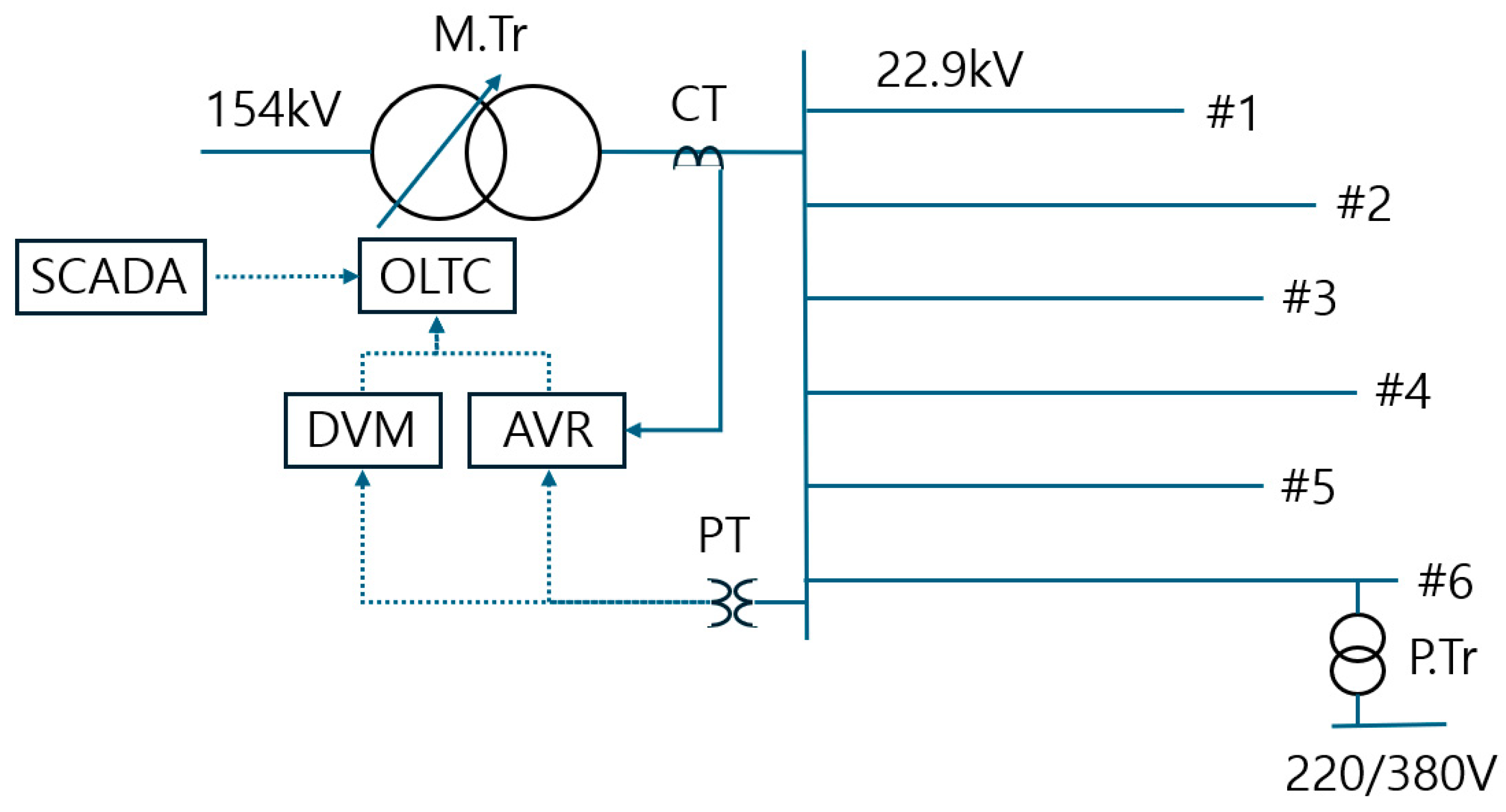
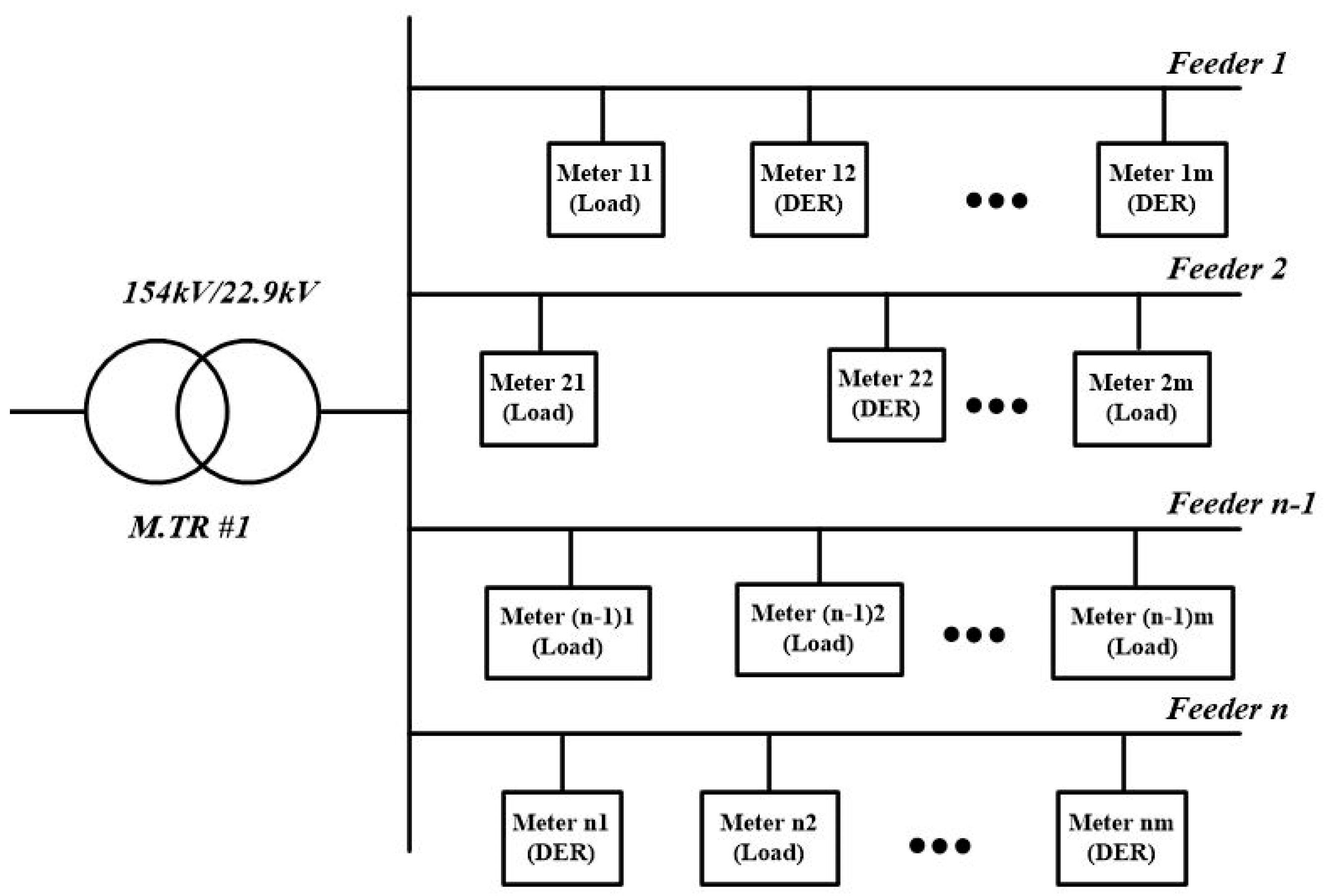


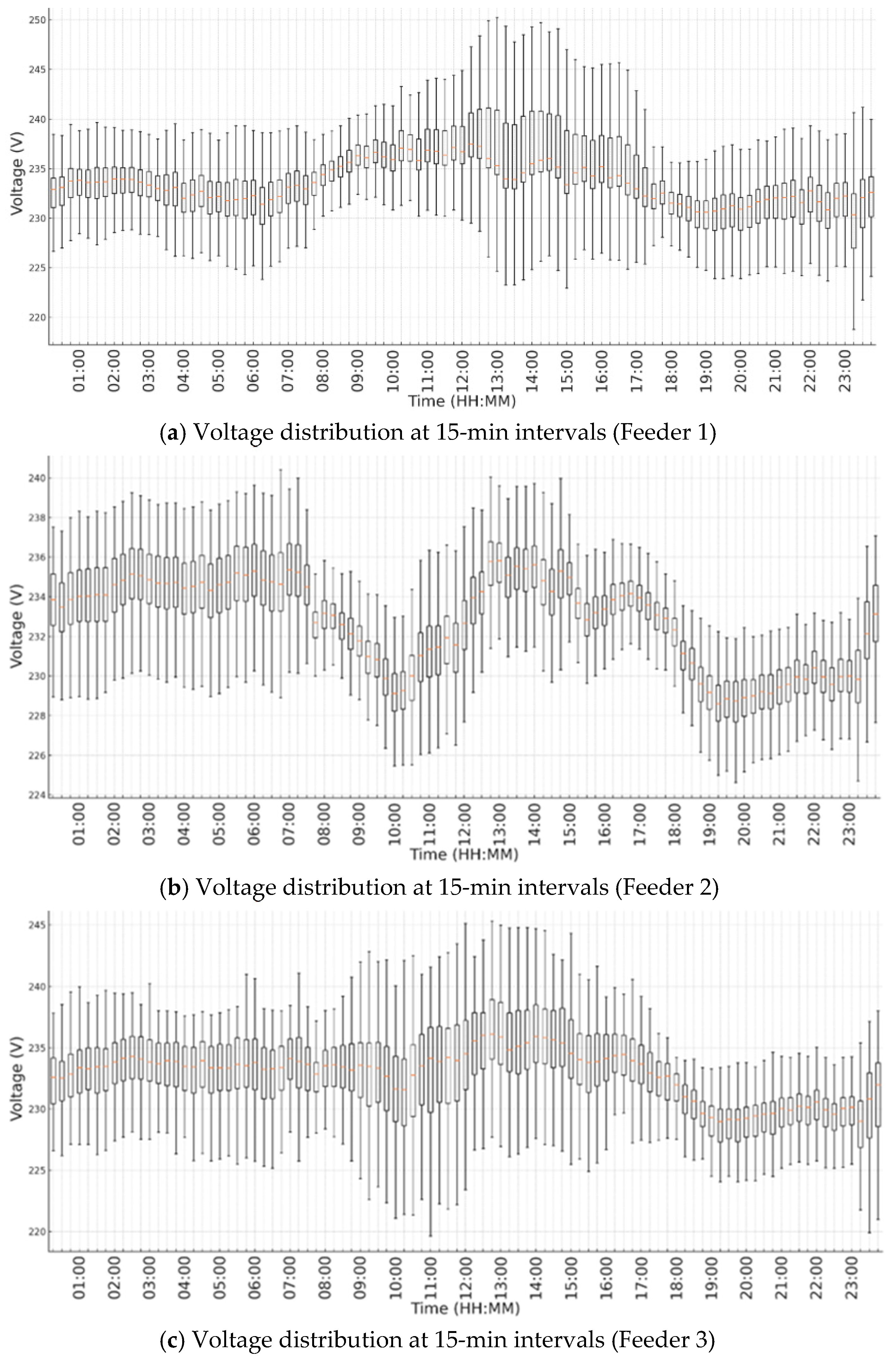
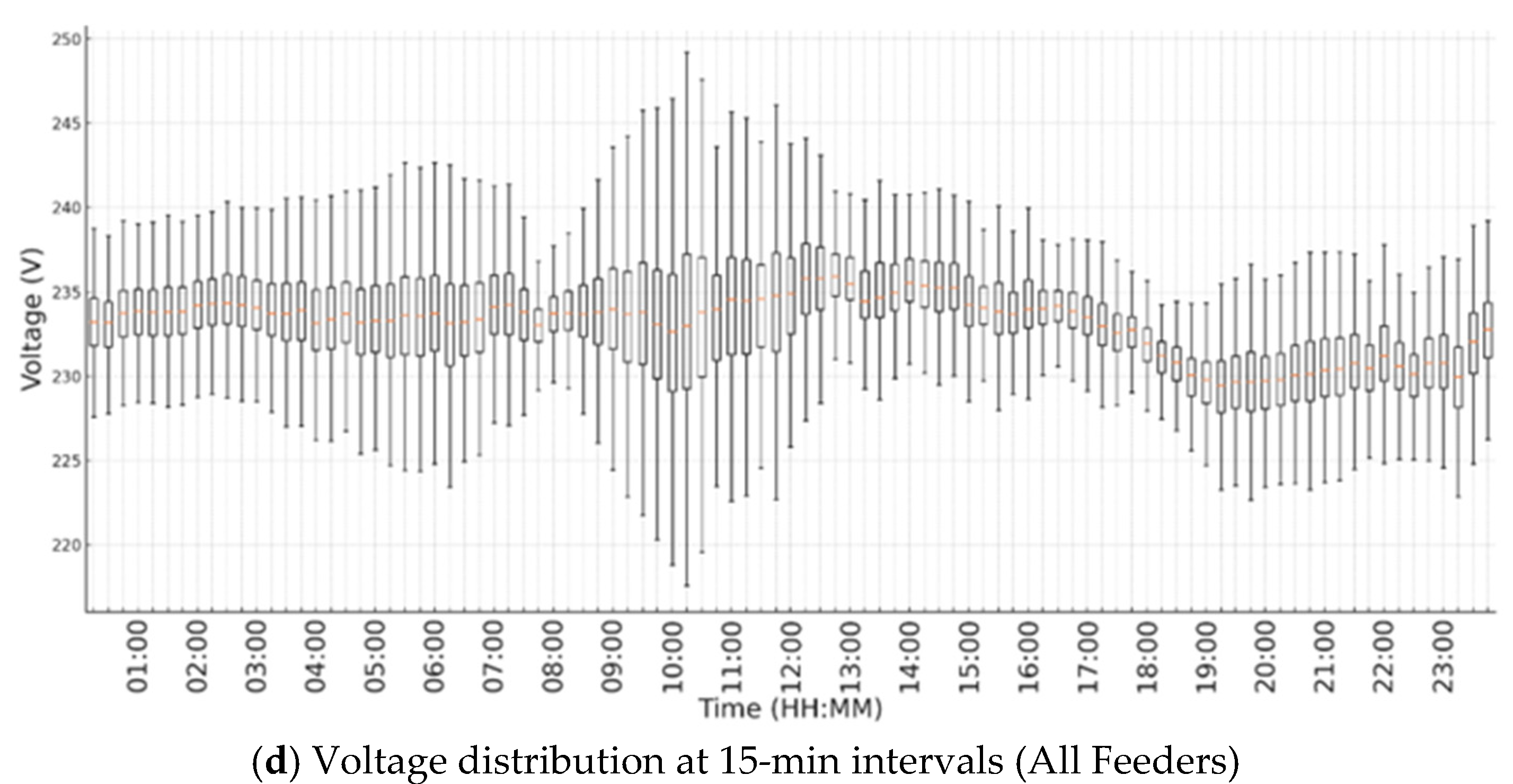

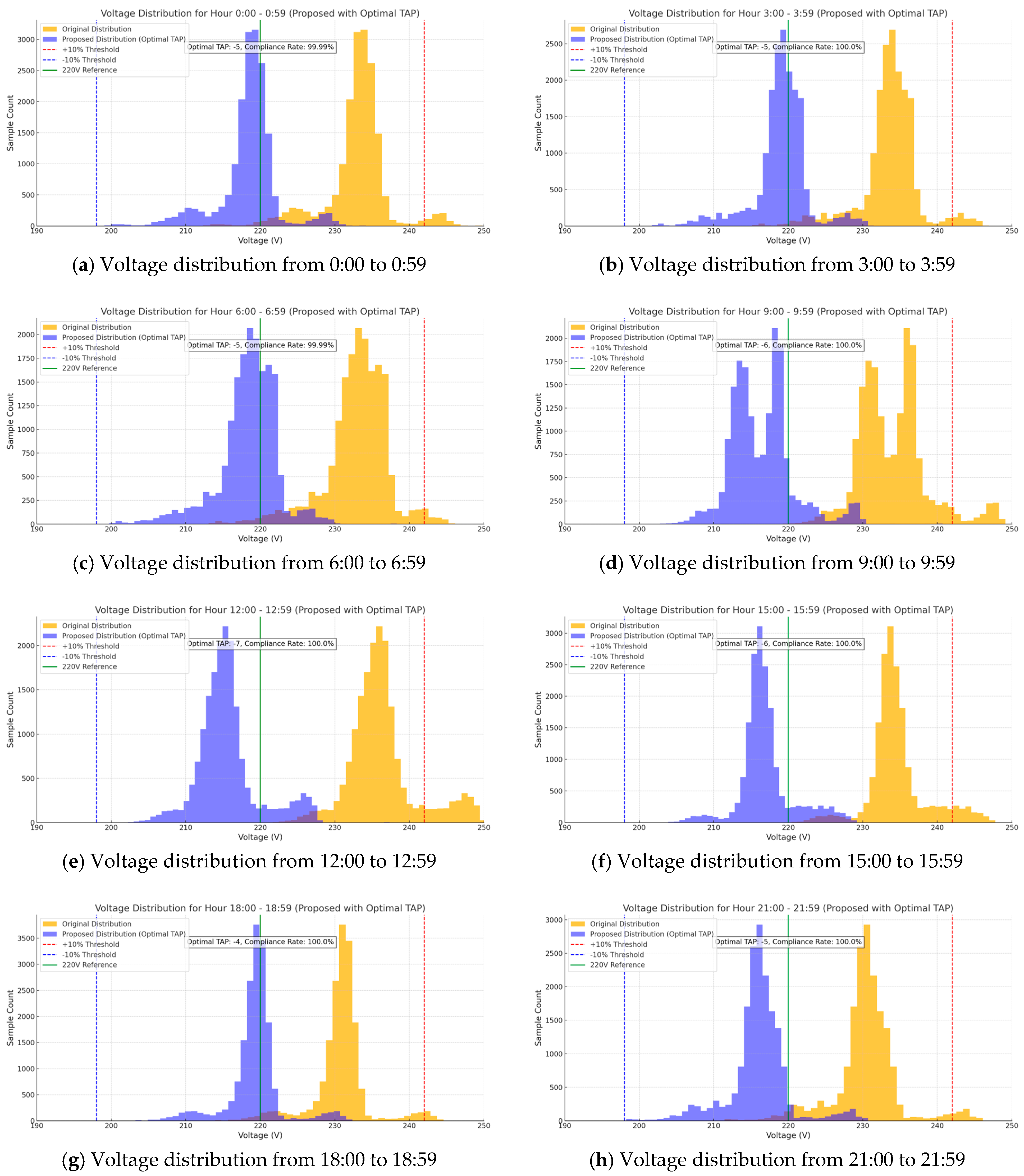


| Tap Position | Total Samples | Non-Compliant Samples | (%) |
|---|---|---|---|
| 0 | 5000 | 500 | 90 |
| 1 | 5000 | 200 | 96 |
| −1 | 5000 | 300 | 94 |
| Feed_No. | Mean_Voltage | Std_Deviation | Max_Voltage [V] | Min_Voltage [V] | Sample_Count |
|---|---|---|---|---|---|
| 1 | 233.73 | 5.53 | 261.74 | 205.05 | 219,552 |
| 2 | 232.57 | 3 | 248.07 | 216.3 | 177,312 |
| 3 | 232.08 | 4.48 | 249.43 | 210.94 | 25,440 |
| ALL | 232.79 | 4.34 | 261.74 | 205.05 | 422,304 |
| Feed_NO | Total_Meters | Non-Compliant Meters | Compliant Meters | RM (%) |
|---|---|---|---|---|
| 1 | 2287 | 553 | 1734 | 75.82 |
| 2 | 1847 | 2 | 1845 | 99.89 |
| 3 | 265 | 10 | 255 | 96.23 |
| ALL | 4399 | 565 | 3834 | 87.16 |
| Feed_NO | Total Samples | Non-Compliant Samples | Compliant Samples | RS (%) | |
|---|---|---|---|---|---|
| Overvoltage | Undervoltage | ||||
| 1 | 219,552 | 20,064 | 0 | 199,488 | 90.86 |
| 2 | 177,312 | 97 | 0 | 177,215 | 99.95 |
| 3 | 25,440 | 112 | 0 | 25,328 | 99.56 |
| ALL | 422,304 | 20,273 | 0 | 402,031 | 95.2 |
| Components | Description |
|---|---|
| Main Transformer (M.TR) | A 154 kV/22.9 kV transformer with an OLTC, featuring 33 tap positions for 1.25% voltage adjustments per tap. |
| Smart Meters | A total of 4399 smart meters providing 15 min interval voltage data for the SNB-VCR calculation. |
| Feeders | Three feeders with unique load profiles, DER levels, and voltage regulation challenges. |
| Regulatory Standards | A voltage range of ±10% for MV and ±6% for LV, as per South Korean Electric Utility Act. |
Disclaimer/Publisher’s Note: The statements, opinions and data contained in all publications are solely those of the individual author(s) and contributor(s) and not of MDPI and/or the editor(s). MDPI and/or the editor(s) disclaim responsibility for any injury to people or property resulting from any ideas, methods, instructions or products referred to in the content. |
© 2025 by the authors. Licensee MDPI, Basel, Switzerland. This article is an open access article distributed under the terms and conditions of the Creative Commons Attribution (CC BY) license (https://creativecommons.org/licenses/by/4.0/).
Share and Cite
Lim, H.; Jo, J.; Chun, K.-H. Optimal On-Load Tap Changer Tap Control Method for Voltage Compliance Rate Improvement in Distribution Systems, Based on Field Measurement Data. Energies 2025, 18, 439. https://doi.org/10.3390/en18020439
Lim H, Jo J, Chun K-H. Optimal On-Load Tap Changer Tap Control Method for Voltage Compliance Rate Improvement in Distribution Systems, Based on Field Measurement Data. Energies. 2025; 18(2):439. https://doi.org/10.3390/en18020439
Chicago/Turabian StyleLim, Hanmin, Jongmin Jo, and Kwan-Ho Chun. 2025. "Optimal On-Load Tap Changer Tap Control Method for Voltage Compliance Rate Improvement in Distribution Systems, Based on Field Measurement Data" Energies 18, no. 2: 439. https://doi.org/10.3390/en18020439
APA StyleLim, H., Jo, J., & Chun, K.-H. (2025). Optimal On-Load Tap Changer Tap Control Method for Voltage Compliance Rate Improvement in Distribution Systems, Based on Field Measurement Data. Energies, 18(2), 439. https://doi.org/10.3390/en18020439










